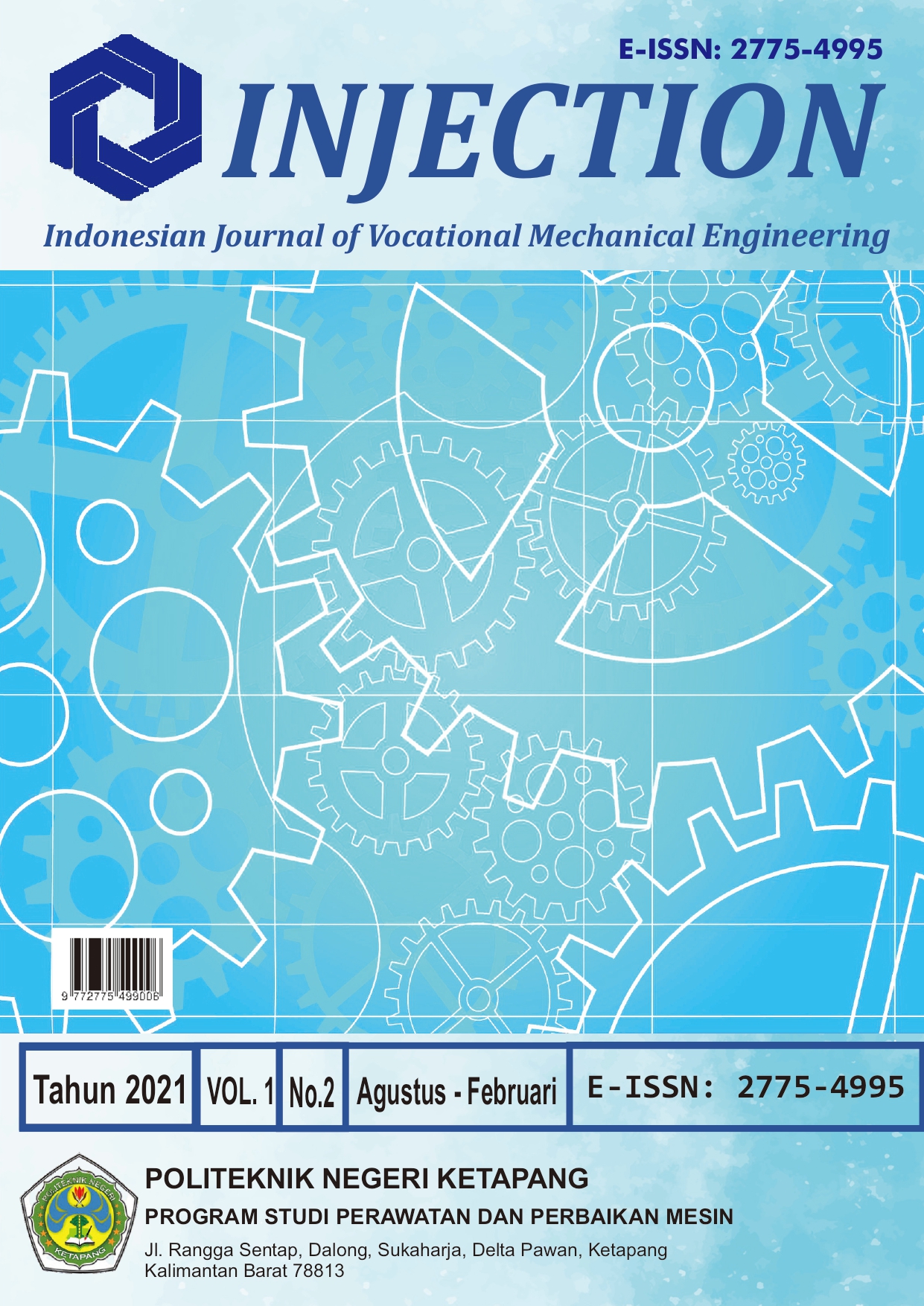STUDI KARAKTERISTIK FISIK DAN NYALA API BRIKET DAUN BAMBU
DOI:
https://doi.org/10.58466/injection.v1i2.1383Kata Kunci:
Briket, Daun, Bambu jawa, Bambu ori, Karakteristik fisik, Nyala apiAbstrak
Briket merupakan bahan bakar padat yang berasal dari limbah biomassa diperoleh dari hasil pengempaan bahan berbentuk serbuk. Penelitian ini bertujuan untuk mendapatkan karakteristik fisik dan karakteristik nyala api briket daun bambu jawa (gigantochloa apus) dan briket daun bambu ori (bambusa arundinacea). Metode yang digunakan dalam penelitian ini adalah memvariasi beban pengepresan 5 kg, 10 kg, 15 kg, serta ukuran serbuk briket (partikel) 20, 40, 60, cetakan berbentuk tabung silinder dengan diameter 38 mm dan diameter lubang bagian dalam 9 mm. Analisis meliputi karakteristik produk api (luas, warna dan temperatur) dan morfologi permukaan briket. Beban pengepresan berpengaruh terhadap karakteristik nyala api yang dihasilkan. Hasil penelitian menunjukkan jenis bambu, ukuran partikel biomassa dan beban pengepresan berpengaruh terhadap karakteristik nyala api. Hasil pengukuran Image J telah mengungkap morfologi permukaan briket yang berpengaruh terhadap karakteristik nyala api briket daun bambu.
Referensi
Kholiq, I. (2015). Pemanfaatan Energi Alternatif Sebagai Energi Terbarukan Untuk Mendukung Subtitusi BBM. Jurnal IPTEK. ISSN: 2477-507. 19(2): 75-90.
Dharma, U. S. (2013). Pemanfaatan Biomassa Limbah Jamur Tiram Sebagai Bahan Bakar Alternatif Untuk Proses Sterilisasi Jamur Tiram. Jurnal Turbo Universitas Muhammadiyah Metro. ISSN 2301-6663 Vol. 2 (2).
Yuda pratama, I. P. A. Winaya, I. N. S. Suryawan I. G. P. (2019). Uji Reaktor Gasifikasi Downdraft Biomassa Sampah Kota. Jurnal METTEK, Universitas Udayana. Issn: 2502-0829. 5 (2): 110-118.
Patabang, B. (2011). Studi Karakteristik Termal Briket Arang Kulit Buah Kakao. Jurnal Mekanikal. ISSN: 2086 – 3403. 2 (1): 23–31.
Prakobboon, N. & Vahdati, M. (2013) ‘Review Of The Potensia For Co-Firing Of Cassava Rhizome For Generating Heat And Power In Cassava Based Bio Ethanol Plant In Thailand’, International Journal Of Biomass & Renewables, 2(2), Hal. 14–22.
Rizwandi. MHD. & Alfansuri. (2019). Analisa Efisiensi Alat Destilasi Asap Cair Terhadap Kuantitas Asap Cair Di Dapur Arang (Suku Asli) Desa Jangkang. Jurnal Teknik Mesin Terapan. ISSN: 2597-9140. 3 (2):88-95.
Aisyah, I. S., Saifullah, A. & Taufik, S. (2017). Proses Desain Dan Pengujian Mesin Press Hidrolik Briket Limbah Bambu. Seminar Nasional Teknologi Dan Rekayasa (Sentra). Universitas Muhammadiyah Malang. ISSN: 2527-604.
Yani, A. P. (2012). Keanekaragaman dan Populasi Bambu Di Desa Talang Pauh Bengkulu Tengah. Jurnal Hutan Lestari. ISSN: 1412-3617. 10 (1)
Sari, E. Indriyanto. & Bintoroa, A. (2016). Respon Setek Cabang Bambu Betung (Dendrocalamus Asper) Akibat Pemberian Asam Indol Butirat (Aib). Jurnal Sylva Lestari Universitas Lampung. ISSN: 2339-0913. 4 (2): 61-68.
Iskandar,T. Suryanti, F. (2015). Efektivitas Bentuk Geometri dan Berat Briket Bioarang Dari Bambu Terhadap Kualitas Penyalaan dan Laju Pembakaran. Jurnal Teknik Kimia Universitas Tribhuwana Tunggadewi. 10 (1): 8-12.
Wandi, A. Harri, S. & Askin. (2015). Pemanfaatan Limbah Daun Kering Menjadi Briket Untuk Bahan Bakar Tungku, Berkala. Jurnal Ilmiah Pertanian. 1(1):1-6.
Alfajriandi. Hamzah, F. & Hamzah, F. H. (2017). Perbedaan Ukuran Partikel Terhadap Kualitas Briket Arang Daun Pisang Kering. Jurnal Jom Faperta Universitas Riau, 4 (1): 1-13.
Hidayat, M. Iqbalsyah. Carissa, S. N. Fona, Z. & Adriana. (2019). Korelasi Tekanan Pencetakan Terhadap Karakteristik Briket Dengan Variasi Lubang. Journal Of Science And Technology. Issn: 1693-248. 17(2) :1-6.




